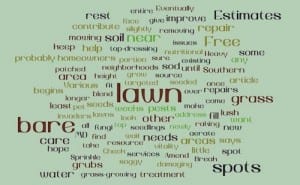Landscaping near me Free Estimates lawn repairs
If your searching for “Landscaping near me Free Estimates” your lawn probably needs some repair.
Landscaping Services Near Me
Of course we want to come out and give you a free estimate for all your lawn care or landscaping needs but in the mean time we hope this article will help with some of your lawn care needs.
Repair bare spots in the lawn
In Southern MD caring for a lawn to keep it lush and green can require equal measures of patience and hard work. Various invaders can attack grass or contribute to its demise. One problem many homeowners face is bare spots.
In neighborhoods throughout Southern MD we find bare spots can occur for various reasons. Heavy foot traffic, grubs or other pests, fungi, pet urine, or too much or too little water can contribute to bare spots. The how-to resource The Spruce says that correcting the source of bare spots can prevent new issues, particularly if grubs or other pests are damaging the grass. Then homeowners can address existing bare areas.
It is unlikely that bare spots will just fill back in on their own. Reseeding spots or using sod to fill in bare areas can help lawns look lush.
- Begin by raking and removing any dead grass and other debris from the lawn. Check to make sure that grubs or insects are not attacking the lawn. If they are, use targeted treatment options for those pests.
- Break up and aerate any soil that is compacted in the bare spot.
- Amend the soil in the bare area with loamy soil or compost to improve on the nutritional makeup and texture so that it is amenable to grass-growing. If you notice that the entire lawn is looking a little sparse, top-dressing the rest of the lawn at this point also can help improve its vitality.
- Sprinkle seeds in the bare spot (disperse seeds over the rest of the lawn if you want to over-seed and improve the thickness of the lawn). If you prefer sod, cut a portion of the sod to fit the bare area and place on the amended soil.
- The Scotts company says to lightly water newly seeded or sodded areas daily for at least two weeks to keep the top inch of soil consistently moist but not soggy. Gradually water more as the seedlings develop and the grass begins to fill in. Deep water at least once or twice a week after the new grass reaches mowing height.
- The grass should grow slightly longer than the rest of the lawn, and wait until the color of the patched area begins to blend in with the rest of the lawn before mowing. This could take a few weeks, and the area should be avoided until then.
Eventually, and with treatment, bare spots can be remedied and become indistinguishable from other areas of the lawn.
AFTER READING THIS ARTICLE OTHERS READ:

